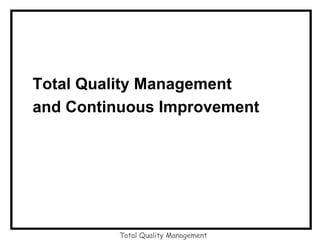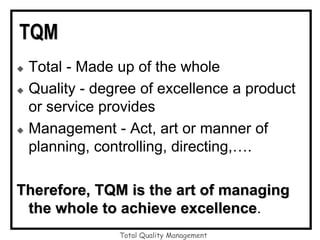TQM ppt.ppt
- 1. Total Quality Management Total Quality Management and Continuous Improvement
- 2. Total Quality Management TQM Total - Made up of the whole Quality - degree of excellence a product or service provides Management - Act, art or manner of planning, controlling, directing,…. Therefore, TQM is the art of managing the whole to achieve excellence.
- 3. Total Quality Management What does TQM mean? Total Quality Management means that the organization's culture is defined by and supports the constant attainment of customer satisfaction through an integrated system of tools, techniques, and training. This involves the continuous improvement of organizational processes, resulting in high quality products and services.
- 4. Total Quality Management What’s the goal of TQM? “Do the right things right the first time, every time.”
- 5. Total Quality Management Another way to put it At it’s simplest, TQM is all managers leading and facilitating all contributors in everyone’s two main objectives: (1) total client satisfaction through quality products and services; and (2) continuous improvements to processes, systems, people, suppliers, partners, products, and services.
- 6. Total Quality Management Productivity and TQM Traditional view: • Quality cannot be improved without significant losses in productivity. TQM view: • Improved quality leads to improved productivity.
- 7. Total Quality Management Basic Tenets of TQM 1. The customer makes the ultimate determination of quality. 2. Top Management must provide leadership and support for all quality initiatives. 3. Preventing variability is the key to producing high quality. 4. Quality goals are a moving target, thereby requiring a commitment toward continuous improvement. 5. Improving quality requires the establishment of effective metrics. We must speak with data and facts not just opinions.
- 8. Total Quality Management The three aspects of TQM Counting Customers Culture Tools, techniques, and training in their use for analyzing, understanding, and solving quality problems Quality for the customer as a driving force and central concern. Shared values and beliefs, expressed by leaders, that define and support quality.
- 9. Total Quality Management Total Quality Management and Continuous Improvement TQM is the management process used to make continuous improvements to all functions. TQM represents an ongoing, continuous commitment to improvement. The foundation of total quality is a management philosophy that supports meeting customer requirements through continuous improvement.
- 10. Total Quality Management Continuous Improvement versus Traditional Approach Market-share focus Individuals Focus on ‘who” and “why” Short-term focus Status quo focus Product focus Innovation Fire fighting Customer focus Cross-functional teams Focus on “what” and “how” Long-term focus Continuous improvement Process improvement focus Incremental improvements Problem solving Traditional Approach Continuous Improvement
- 11. Total Quality Management Quality Throughout “A Customer’s impression of quality begins with the initial contact with the company and continues through the life of the product.” • Customers look to the total package - sales, service during the sale, packaging, deliver, and service after the sale. • Quality extends to how the receptionist answers the phone, how managers treat subordinates, how courteous sales and repair people are, and how the product is serviced after the sale. “All departments of the company must strive to improve the quality of their operations.”
- 12. Total Quality Management Value-based Approach Manufacturing Dimensions • Performance • Features • Reliability • Conformance • Durability • Serviceability • Aesthetics • Perceived quality Service Dimensions • Reliability • Responsiveness • Assurance • Empathy • Tangibles
- 13. Total Quality Management The TQM System Customer Focus Process Improvement Total Involvement Leadership Education and Training Supportive structure Communications Reward and recognition Measurement Continuous Improvement Objective Principles Elements
Editor's Notes
- #2: 1












